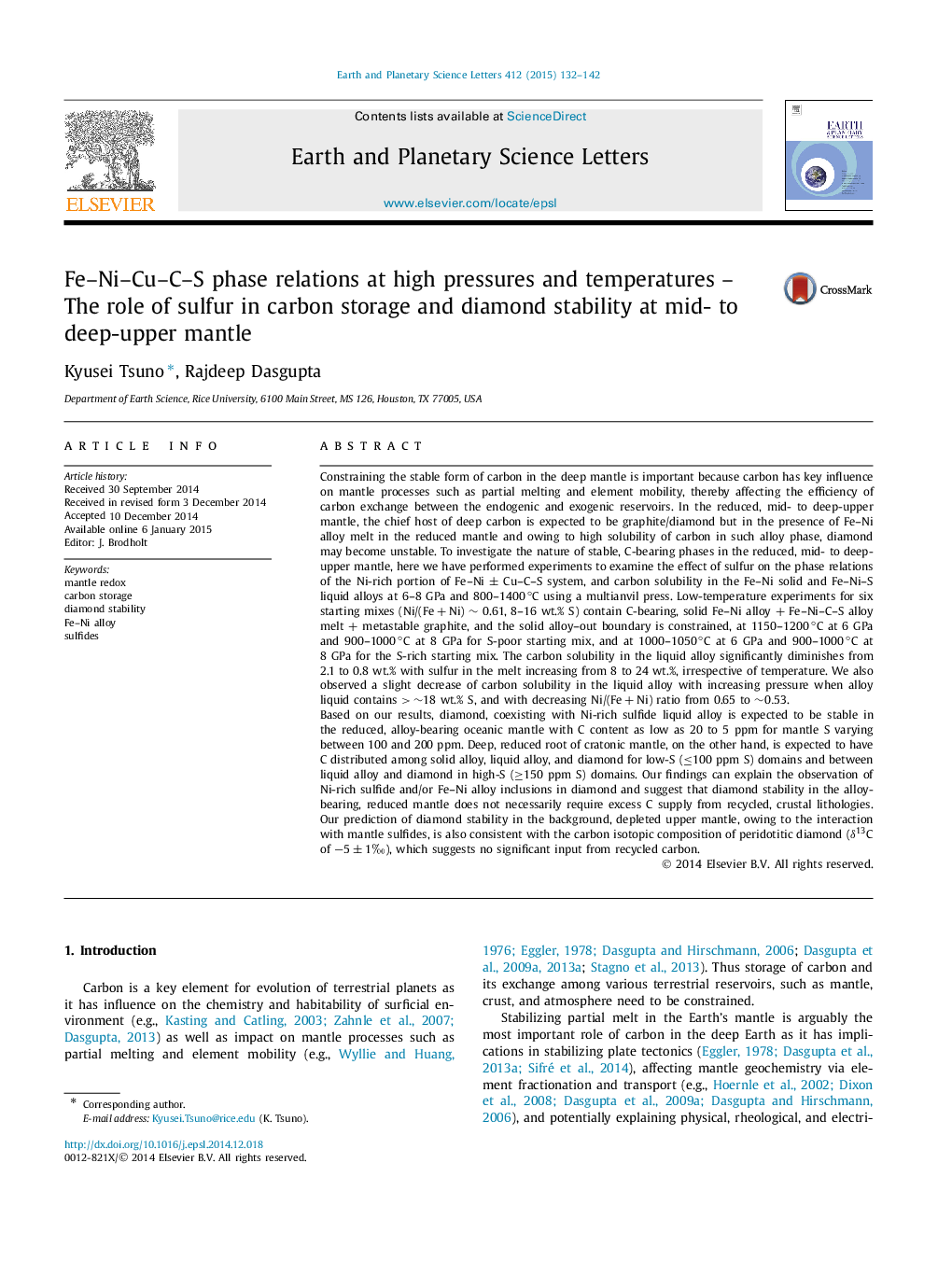| Article ID | Journal | Published Year | Pages | File Type |
|---|---|---|---|---|
| 6428641 | Earth and Planetary Science Letters | 2015 | 11 Pages |
â¢Dissolved S expands the stability field of Fe-Ni-C alloy liquid to lower temperatures.â¢C solubility in Fe-Ni ± Cu-S liquid alloy decreases with increasing S content.â¢Diamond stability in C-poor, depleted oceanic mantle is aided by sulfur.â¢In deep cratonic mantle, C is distributed among diamond, and solid and liquid alloys.â¢Our data explains the rarity of alloy/carbide but abundant sulfide inclusions in diamonds.
Constraining the stable form of carbon in the deep mantle is important because carbon has key influence on mantle processes such as partial melting and element mobility, thereby affecting the efficiency of carbon exchange between the endogenic and exogenic reservoirs. In the reduced, mid- to deep-upper mantle, the chief host of deep carbon is expected to be graphite/diamond but in the presence of Fe-Ni alloy melt in the reduced mantle and owing to high solubility of carbon in such alloy phase, diamond may become unstable. To investigate the nature of stable, C-bearing phases in the reduced, mid- to deep-upper mantle, here we have performed experiments to examine the effect of sulfur on the phase relations of the Ni-rich portion of Fe-Ni ± Cu-C-S system, and carbon solubility in the Fe-Ni solid and Fe-Ni-S liquid alloys at 6-8 GPa and 800-1400â°C using a multianvil press. Low-temperature experiments for six starting mixes (Ni/(Fe + Ni) â¼ 0.61, 8-16 wt.% S) contain C-bearing, solid Fe-Ni alloy + Fe-Ni-C-S alloy melt + metastable graphite, and the solid alloy-out boundary is constrained, at 1150-1200â°C at 6 GPa and 900-1000â°C at 8 GPa for S-poor starting mix, and at 1000-1050â°C at 6 GPa and 900-1000â°C at 8 GPa for the S-rich starting mix. The carbon solubility in the liquid alloy significantly diminishes from 2.1 to 0.8 wt.% with sulfur in the melt increasing from 8 to 24 wt.%, irrespective of temperature. We also observed a slight decrease of carbon solubility in the liquid alloy with increasing pressure when alloy liquid contains >â¼18 wt.% S, and with decreasing Ni/(Fe + Ni) ratio from 0.65 to â¼0.53.Based on our results, diamond, coexisting with Ni-rich sulfide liquid alloy is expected to be stable in the reduced, alloy-bearing oceanic mantle with C content as low as 20 to 5 ppm for mantle S varying between 100 and 200 ppm. Deep, reduced root of cratonic mantle, on the other hand, is expected to have C distributed among solid alloy, liquid alloy, and diamond for low-S (â¤100 ppm S) domains and between liquid alloy and diamond in high-S (â¥150 ppm S) domains. Our findings can explain the observation of Ni-rich sulfide and/or Fe-Ni alloy inclusions in diamond and suggest that diamond stability in the alloy-bearing, reduced mantle does not necessarily require excess C supply from recycled, crustal lithologies. Our prediction of diamond stability in the background, depleted upper mantle, owing to the interaction with mantle sulfides, is also consistent with the carbon isotopic composition of peridotitic diamond (δ13C of â5±1â°), which suggests no significant input from recycled carbon.
